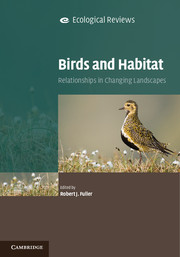Book contents
- Frontmatter
- Contents
- List of Contributors
- Preface
- Part I The complexity of patterns and processes
- Chapter One The bird and its habitat: an overview of concepts
- Chapter Two Habitat quality and habitat occupancy by birds in variable environments
- Chapter Three Spatial variation and temporal shifts in habitat use by birds at the European scale
- Chapter Four Mechanisms and processes underlying landscape structure effects on bird populations
- Chapter Five Avian responses to transitional habitats in temperate cultural landscapes: woodland edges and young-growth
- Chapter Six Habitat associations of birds in complex changing cultural landscapes
- Chapter Seven The importance of habitat heterogeneity at multiple scales for birds in European agricultural landscapes
- Part II Case studies of habitat use and selection
- Part III Wider perspectives
- Species index
- Subject index
- References
Chapter Five - Avian responses to transitional habitats in temperate cultural landscapes: woodland edges and young-growth
Published online by Cambridge University Press: 05 December 2012
- Frontmatter
- Contents
- List of Contributors
- Preface
- Part I The complexity of patterns and processes
- Chapter One The bird and its habitat: an overview of concepts
- Chapter Two Habitat quality and habitat occupancy by birds in variable environments
- Chapter Three Spatial variation and temporal shifts in habitat use by birds at the European scale
- Chapter Four Mechanisms and processes underlying landscape structure effects on bird populations
- Chapter Five Avian responses to transitional habitats in temperate cultural landscapes: woodland edges and young-growth
- Chapter Six Habitat associations of birds in complex changing cultural landscapes
- Chapter Seven The importance of habitat heterogeneity at multiple scales for birds in European agricultural landscapes
- Part II Case studies of habitat use and selection
- Part III Wider perspectives
- Species index
- Subject index
- References
Summary
Various kinds of edges and early successional vegetation are characteristic elements of human-modified landscapes. These landscape elements have large effects on the local composition of bird communities and can be thought of as contrasting types of transition. Edges are the spatial transition at the boundary zone between two different vegetation types, whereas land abandonment and woodland management trigger a temporal vegetation transition. This chapter discusses factors influencing variation in the bird communities associated with woodland edges, lowland scrub and young managed woodland. The emphasis is on north west Europe, but extensive comparison is made with processes operating in North America. Bird communities of edges and different types of young-growth are superficially similar, but their associated resources and the processes operating within them may vary substantially.
In recent decades a huge research effort has focused on avian edge effects for the reason that these are widely considered to be one of the main mechanisms by which habitat fragmentation reduces habitat quality for interior forest species (see also Chapter 4). Surprisingly little work on edge effects has been undertaken in Europe, where forest fragmentation is predominantly an ancient phenomenon. By comparison with edges, young-growth habitats have received relatively little attention from ecologists, though this has recently started to change in North America, where reduction of early successional habitats and declines in associated bird species are evident (Askins, 2001; Brawn et al., 2001; Hunter et al., 2001). There is also a growing concern that population declines are emerging in several young-growth species in Britain (Fuller et al., 2007). Looking to the future, it will become important to develop a more refined understanding of how birds and other organisms use and respond to young-growth. The creation of habitat networks designed as climate change adaptation measures will need to encompass diverse habitat structures of which young-growth will probably form a major component (Ausden and Fuller, 2009).
- Type
- Chapter
- Information
- Birds and HabitatRelationships in Changing Landscapes, pp. 125 - 149Publisher: Cambridge University PressPrint publication year: 2012
References
- 9
- Cited by



